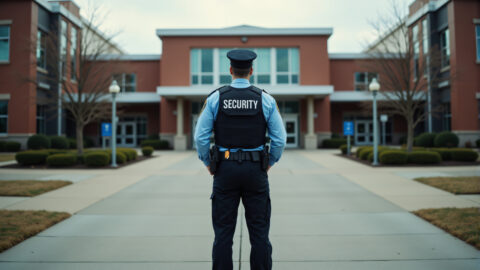A Growing National Threat
Over the past year, dozens of U.S. universities and colleges have been hit with “swatting” incidents — malicious hoax calls designed to provoke a heavy law enforcement response by reporting false emergencies such as active shooters, bombs, or hostage situations. These calls are not innocent pranks; they are disruptive, traumatic, and in some cases, dangerous.
The Department of Homeland Security (DHS) now warns that swatting and related hoax threats are frequent, coordinated, and evolving. According to DHS, these calls are often clustered across multiple institutions in a short period, targeting schools, hospitals, universities, and other critical community organizations. Law enforcement must treat every report as real until proven otherwise — which means campuses experience lockdowns, evacuations, and operational chaos even when the threat is a hoax.
Why Swatting is Particularly Dangerous for Universities
- Disruption to Learning and Research
Universities thrive on stability and predictability. A swatting incident instantly interrupts that rhythm: classrooms are evacuated, lectures are paused, exams delayed, and research labs shuttered. The learning experience is disrupted, and schedules are thrown into disarray. - Strain on Resources
When a swatting call comes in, campus safety teams and local police must drop everything to investigate. According to DHS guidance, this often requires providing access to building floor plans, CCTV, access control systems, and campus contacts. These responses divert resources and budgets, while faculty and administrators scramble to manage communications and calm anxious students. - Psychological Toll on Community
Even after an incident is revealed to be a hoax, the experience is real for those involved. Students hiding under desks or sheltering in locked classrooms still feel fear and trauma. Repeated events erode confidence in the university’s ability to protect its community and can contribute to stress, anxiety, and reduced student wellbeing. - Evolving Tactics
The DHS report highlights that swatting calls are increasingly coordinated and sophisticated, meaning that institutions are not just isolated victims but part of a broader, escalating risk landscape.
What DHS Recommends
The DHS report on swatting and hoax threats (September 2024) highlights several best practices for institutions:
- Build strong partnerships with local law enforcement, including pre-planned walk-throughs of facilities with all police shifts.
- Establish clear internal notification protocols, including who sends alerts, which systems are used, and how quickly communication must go out.
- Ensure ready access to key data: building layouts, access controls, camera feeds, and contact details for decision-makers.
- Conduct after-action reviews and share data with Fusion Centers and the FBI’s Virtual Command Center to help identify broader patterns.
These recommendations are essential. But as many universities are discovering, policies on paper are not enough. In moments of crisis, leaders need practical tools that can operationalize these best practices instantly and reliably.
How SafeZone Empowers Universities to Stay Safe and Operational
This is where SafeZone by CriticalArc makes the difference. SafeZone is not another siloed service or “just another app.” It is a unified safety, security, wellbeing, and emergency management platform that universities use every single day. That everyday familiarity is what makes it so powerful during moments of crisis.
SafeZone helps institutions:
- Coordinate seamlessly in real time — connect campus safety, dispatch, and local responders in one operational picture, so everyone acts quickly and in sync.
- Communicate with clarity — send targeted, precise messages directly to affected groups (e.g., a specific building or floor) to reduce panic and guide safe action.
- Recover faster — validate threats quickly, minimize confusion, and restore teaching and research operations without prolonged downtime.
- Empower the community — enable students, staff, and faculty to discreetly report suspicious behavior or concerns through SafeZone’s tip reporting feature.
- Enable instant incident alerts — allow individuals to raise genuine alerts directly via the SafeZone app, ensuring rapid response when it matters most.
- Ensure visible preparedness and peace of mind — demonstrate proactive readiness that reassures students, staff, and parents, creating an environment where people not only are safe but also feel safe.
 Why a Unified Solution Matters
Why a Unified Solution Matters
When time is of the essence, the difference between disruption and resilience comes down to whether your people have one trusted, familiar platform they already know how to use. SafeZone is integrated into everyday campus life — used routinely for routine safety requests, wellbeing checks, lone-worker support, and emergency management.
That daily use means students, staff, and first responders don’t hesitate in a crisis. They know exactly where to go and what to do. This is what sets SafeZone apart from standalone apps or siloed services: it is not something that sits idle until a major event occurs. It is embedded into the culture of the institution, ready to be leveraged in moments when speed and coordination are critical.
With real-time visualization of responders, fast community-wide communication, and unified coordination with police and emergency services, SafeZone ensures that universities can respond decisively, recover quickly, and preserve the continuity of education.
Conclusion
Swatting and hoax threats are no longer rare disruptions — they are an escalating national challenge. For universities, the stakes are high: protecting students and staff, preserving the integrity of learning, and maintaining community trust.
DHS has provided guidance, but it is up to institutions to put those principles into practice. By adopting a unified, real-time platform like SafeZone, universities can move from being reactive victims of disruption to proactive leaders in safety and resilience.
Swatting may be designed to instill fear and chaos. But with the right tools, universities can ensure it never derails their mission of teaching, discovery, and community.
